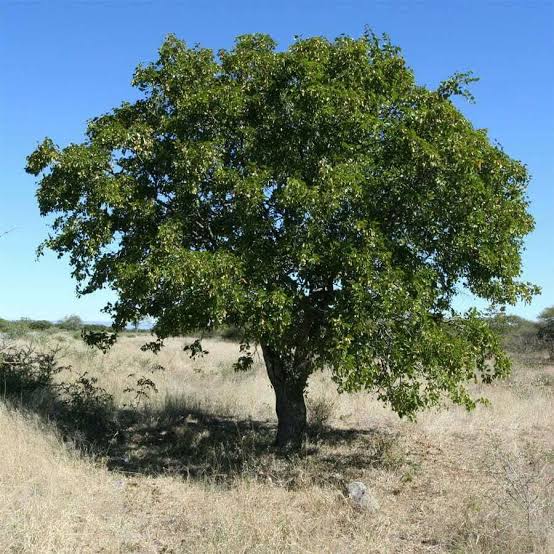Mopani Tree (Mopanieboom) #
Colophospermum mopane

Quick Info #
- Distribution & habitat: From Malawi and Zambia in the north down to Limpopo Province in the south – on dry, low-lying bushveld
- Family: Fabaceae
- Florescence: October to March
- Fruiting: March to June
- Leaf habit: deciduous or semi-deciduous
- Name origin: “Colophospermum” means “oily seed” and “mopane” is derived from the common name
- Other names: mohlanare (Northern Sotho), mopane, mophane (Tswana), turpentine tree
Description #
The mopani can reach anywhere from 18 to 30 m in length depending on where it grows. It has a roundish crown and is often found in the form of a shrub.
The bark is dark grey to brown when aged. It has deep, lengthwise grooves. The leaflets grow in pairs, resulting in a distinctive butterfly shape. They’re glossy and leathery, and smell like turpentine when crushed. The tiny, inconspicuous flowers grow in clusters and are greenish yellow in colour.
The fruits are flat, kidney-shaped, indehiscent pods with oil glands. The seeds inside are wrinkly.
Uses & Ecology #
The brown, orange and red colours during autumn adorn a garden well.
Elephants consume the branches. Cattle, small stock and many other animals eat the leaves. Interestingly, there is a caterpillar called the mopane worm, which also eats the leaves. It is very nutritious to eat a mopane worm.
The wood, being strong and resistant to termites, can be made into solid fence poles and furniture. It’s also great for burning.
Ropes have been woven from the bark.
References #
- Aubrey, A. (2004) Colophospermum mopane. Available at: https://pza.sanbi.org/colophospermum-mopane (Accessed: 03 October 2025)
- Van Wyk, B & P. (1997) Field Guide to Trees of Southern Africa. Cape Town: Struik Publishers.
- Van Wyk, B & P. (2008) Identifiseer die Bome van Suider-Afrika. Cape Town: Struik Publishers.
- Venter, F & J.A. (2002) Benut on Inheemse Bome. Pretoria: Briza Publications.
Caution: Consult a qualified health practitioner before considering medically using or ingesting any plant parts. Any mentioned traditional uses are based on cultural practices and anecdotal evidence. They are not necessarily clinically proven or supported by modern scientific studies.